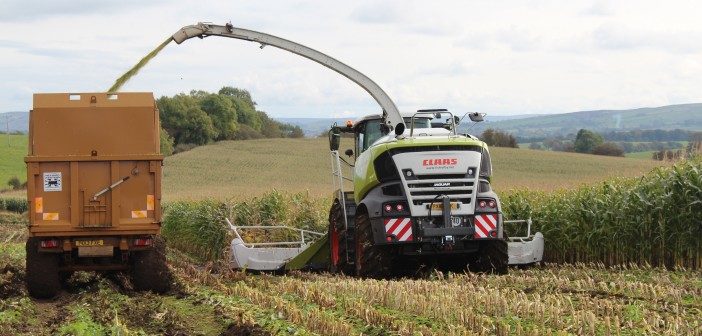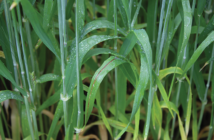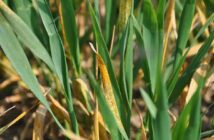The AHDB Recommended Lists for cereals and oilseeds (RL) 2017/18, launched today (28 November), sees 29 new varieties added, including the first soft wheat varieties in four years.
The winter wheat list sees an overall increase of five varieties, while the east/west oilseed rape list has been reduced by four. In total, 28 varieties have been removed from the RL.
Advances in combining high yields with good resistance traits are reflected in disease ratings for new varieties.
Dr Simon Oxley, who heads AHDB’s Crop Production Systems, said: “This year’s biggest change is the addition of six new soft wheat feed varieties – the first new entrants for four years to a wheat category whose markets include distilling, soft biscuit wheat for export, and soft endosperm feed.
“This year, northern growers aiming for distilling markets have some exciting new varieties to consider, with improved yields, first-rate septoria tritici resistance and earlier maturity. Growers further south looking for uks biscuit export varieties or distilling varieties will also find something new.
“Feed growers in soft and hard feed markets will find varieties with a combination of high yield, early maturity, stiff straw and better septoria resistance.”
New wheat varieties resist yellow rust, despite recent race changes
Changes in the yellow rust population last season caused the ratings of some recommended wheat varieties to fall but this year’s new entrants show good resistance to the disease, with ratings of 7 to 9. Most wheat varieties new to the RL are in the relatively low risk category, with high disease and lodging ratings and a high untreated yield.
Dr Oxley said: “The relative risk of these new varieties is low, providing confidence to early adopters of new varieties. For all varieties, new and old, the RL shows information from previous seasons, so there is always a chance risks may change. AHDB disease monitoring is important for identifying any changes that occur in the new season.”
Septoria tritici ratings are now reported to a decimal place, showing exactly where on the rating scale varieties lie and the incremental improvements being made by breeders. Eight of the new varieties have resistance scores between 6.2 and 7.3.
New to the RL – reporting on percentage protein in milling trials
Protein is an important measure for the market when selecting milling wheat varieties. This year’s list shows the percentage protein achieved in trials grown to milling specification, as well as the protein levels reported in all trials, both feed and milling.
Although the RL does not measure the quality of the protein – which can be more important than the total protein – varieties are tested in baking tests managed by nabim to ensure they are up to the mark for the quality bread markets.
Higher-yielding quality wheats are more than capable of achieving market requirements for protein. This year’s list includes a new provisional nabim Group 1 high-yielding, high-quality bread-making wheat, KWS Zyatt.
The spring wheat list also sees the introduction of two new high-yielding nabim group 2 milling wheats, KWS Cochise and KWS Chilham. Both have the flexibility to be drilled in the autumn or spring, having orange wheat blossom midge resistance.
OSR – balancing yields and disease resistance
The new oilseed rape lists see advances in maintaining the yields growers have come to expect, together with superior disease resistance.
“New varieties show excellent overall resistance to light leaf spot and phoma stem canker. Growers looking for top notch resistance with opportunities for better integrated disease management have a new semi-dwarf variety to consider in DK Secret.”
The oilseed rape lists also help to directly compare variety performance in all regions, with this year’s publication of a UK gross output and seed yield for current and new varieties.
New spring barley variety has potential to be an innovative first for brewing.
Growers of feed barley can look forward to three new winter feed varieties – a two-row feed for the north (KWS Creswell), as well as a six-row conventional (Funky) and six-row hybrid (Sunningdale) for the UK. There are three new spring barley varieties, under test for brewing, malt distilling and brewing, and grain distilling. Further tests are required before they achieve IBD approval, but this year sees the first potential brewing variety lacking a gene for lipoxygenase production, Chanson. This helps to improve flavour stability in the end product.
Summaries of the new AHDB Recommended Lists are available on the AHDB website at cereals.ahdb.org.uk/varieties
The full AHDB Recommended Lists for cereals and oilseeds booklet will be distributed in early 2017.
New online tools identify regional variety performance and give growers an opportunity to compare current and new varieties. Harvest 2016 tools are available now and the Variety Selection tool will be updated with 2017/18 RL data in the spring.
Recommended Lists 2017/18 – variety notes
Recommended List for winter wheat
KWS Zyatt is a new quality provisional nabim Group 1 winter wheat, which achieved good bread making qualities in line with other Group 1 varieties. It achieves the highest yield of all the Group 1 varieties and similar proteins to Skyfall. It has stiff straw with good resistance to septoria tritici (6.4), yellow rust (7), brown rust (6) mildew (7) and eyespot (7). It is also similar in maturity to Crusoe, and Skyfall.
It will undergo further quality testing as part of nabim’s two-step process in granting full Group 1 status.
Six new soft feed varieties have been added to the Recommended Lists.
Bennington is the highest yielding Group 4 soft variety on the AHDB Recommended List, advancing the yields in this soft feed category to levels growers expect from hard group 4 varieties. It is recommended for the east and west regions where the highest yields were seen. Its high yield is in combination with stiff straw, good resistance to yellow rust (7), brown rust (7), mildew (7) and septoria tritici (6.2)
LG Sundance is a high yielding Group 4 soft feed variety for the UK, which is suitable for distilling with a medium rating. It also has the highest rating for septoria tritici (7.3) of all varieties on the Recommended List – a breakthrough in achieving good resistance and high yield. It also has stiff straw, orange wheat blossom midge resistance and good resistance to yellow rust (9).
Savello is a high-yielding Group 4 soft feed variety for the north, which is suitable for distilling with a medium rating. It has a high treated yield with the advantage of being earlier maturing than both Leeds and Revelation. It is stiff-strawed and has good resistance to yellow rust (8) and mildew (7). Although susceptible to brown rust (4), this is of lower risk in most seasons in the north of the UK.
LG Motown is a high yielding Group 4 soft feed for the UK, which is an early maturing variety suitable for distilling with a medium rating. It has stiff straw and an overall good disease resistance package for mildew (8), yellow rust (9), brown rust (7) and septoria tritici (5.8).
Moulton is a high yielding early maturing Group 4 soft feed variety for the UK, with a combination of being suitable for distilling with a medium rating and has uks export potential, achieving samples with high specific weight and Hagberg Falling Number. It has stiff straw and an overall good disease resistance package for mildew (7), yellow rust (8), brown rust (7) and septoria tritici (6.5).
Hardwicke is a high-yielding early maturing Group 4 soft feed variety for the north, suitable for distilling with a medium rating. It is stiff-strawed early maturing with good resistance to yellow rust (8), brown rust (6) and septoria tritici (5.9).
Four new hard feed varieties have also been added to the Recommended List.
KWS Kerrin holds the crown as the highest yielding variety on the list recommended for the east and west. This yield advantage is in combination with stiff straw, orange wheat blossom midge resistance and good resistance to mildew (7), yellow rust (7), and brown rust (7).
Shabras is recommended for the UK and combines a high yield with early maturity. It also has stiff straw and good resistance to mildew (7), yellow rust (8) and septoria tritici (6.2). The variety is, however, susceptible to brown rust (4).
Freiston combines a high yield, early maturity and stiff straw, with good resistance to mildew (7), yellow rust (9), brown rust (7) and septoria tritici (6.7).
Dunston combines a high yield with stiff straw and good resistance to yellow rust (7), brown rust (6), septoria tritici (6.7) and eyespot (6). This combination makes it one of the relatively lower risk varieties on the List.
Recommended List for spring wheat

KWS Cochise is a new quality nabim Group 2 spring wheat, it shows a degree of variability in testing over three years, leading to its group 2 rating. It has the highest yield of all varieties in spring-sown trials, in combination with orange wheat blossom midge resistance, early maturity and good resistance to brown rust (8) and septoria tritici (6).
KWS Chilham is a new quality provisional nabim Group 2 spring wheat, which tends to show lower protein than a Group 1 variety, but with stronger gluten. It has good resistance to yellow rust (7) and septoria tritici (6), but it is susceptible to brown rust (4). It also has resistance to orange wheat blossom midge
Recommended List for winter barley

Sunningdale is a very high yielding hybrid six-row feed barley. Although it has a similar yield to Bazooka, it is earlier maturing with shorter straw. Sunningdale has performed particularly well in the north where it is the highest yielding variety on the Recommended List. It widens the choice available to six-row hybrid feed varieties for growers throughout the UK. It has good resistance to brown rust (6), rhynchosporium (7) and net blotch (6), plus resistance to barley yellow mosaic virus.
Funky is a very high yielding early maturing conventional six-row feed with good resistance to mildew (6), brown rust (8), rhynchosporium (7) and net blotch (6), plus resistance to barley yellow mosaic virus. It is currently the only conventional six-row variety on the List.
KWS Cresswell is a high yielding early maturing two-row feed variety for the north. It has stiff straw and good resistance to rhynchosporium (6), plus resistance to barley yellow mosaic virus.
Recommended List for spring barley

Chanson is under test for brewing and is the first recommended variety lacking a gene for lipoxygenase production. It is early maturing and has a high yield, particularly in the east and north. It can produce a lower than average specific weight, but screenings are in line with other brewing varieties. It is best to consider Chanson as a conventional variety under test for brewing, but with potential added benefits to the end user.
LG Opera is under test for brewing and malt distilling. It is a high yielding early maturing variety, with relatively short straw and good resistance to brackling and good resistance to mildew (9)
Dioptric is recommended for the north as a high yielding variety under test for grain distilling. It has a high specific weight, short straw with good resistance to brackling and good resistance to mildew (9) and ramularia (8).
Recommended Lists for oilseed rape

North

Flamingo is a conventional variety that performs well on gross output in the East/West and combines early maturity and stiff stems with high resistance to light leaf spot (7). Phoma stem canker (4) will, however, require attention.
Nikita now has a UK recommendation adding the East/West region to the North recommendation gained last year. It has a high UK gross output in combination with stiff stems, relatively early maturity and high resistance to light leaf spot (7). Phoma stem canker (4) will, however, require attention.
Aquila is a restored hybrid that has a high gross output in combination with stiff stems, good resistance to light leaf spot (6) and to phoma stem canker (8). This variety achieves high levels of resistance to both diseases with no apparent penalties in gross output or agronomics.
DK Secret is a restored hybrid semi-dwarf variety and will be the shortest variety on the List (9) in combination with high resistance to light leaf spot (7) and phoma stem canker (8). The gross output is favourable when compared with the only other specialist semi-dwarf variety, Troy.
Ergo is a described high erucic acid (HEAR) variety for the east/west region. The oils are used for industrial processing and care should be taken to keep HEAR varieties away from others.
Recommended Lists for oats
RGT Victorious and Griffin are conventional winter oat husked varieties. RGT Victorious combines high yields with early maturity and achieves a good specific weight and good kernel content. Griffin is also high yielding with similar positive characteristics in specific weight and kernel content. Both varieties will, however, require attention to the risk of lodging.
Peloton is a naked variety, with a combination of high yield and early maturity. It has good resistance to mildew (6) and crown rust (6).
Yukon and WPB Elyann are two new husked spring oat varieties. Yukon achieves a high yield, early maturity and stiff straw. It achieves good specific weight and kernel content. It has good resistance to mildew (8). WPB Elyann is also early maturing but slightly lower yielding, and has a very high kernel content at 80.7%, combined with a good specific weight. It has good resistance to mildew (7).






